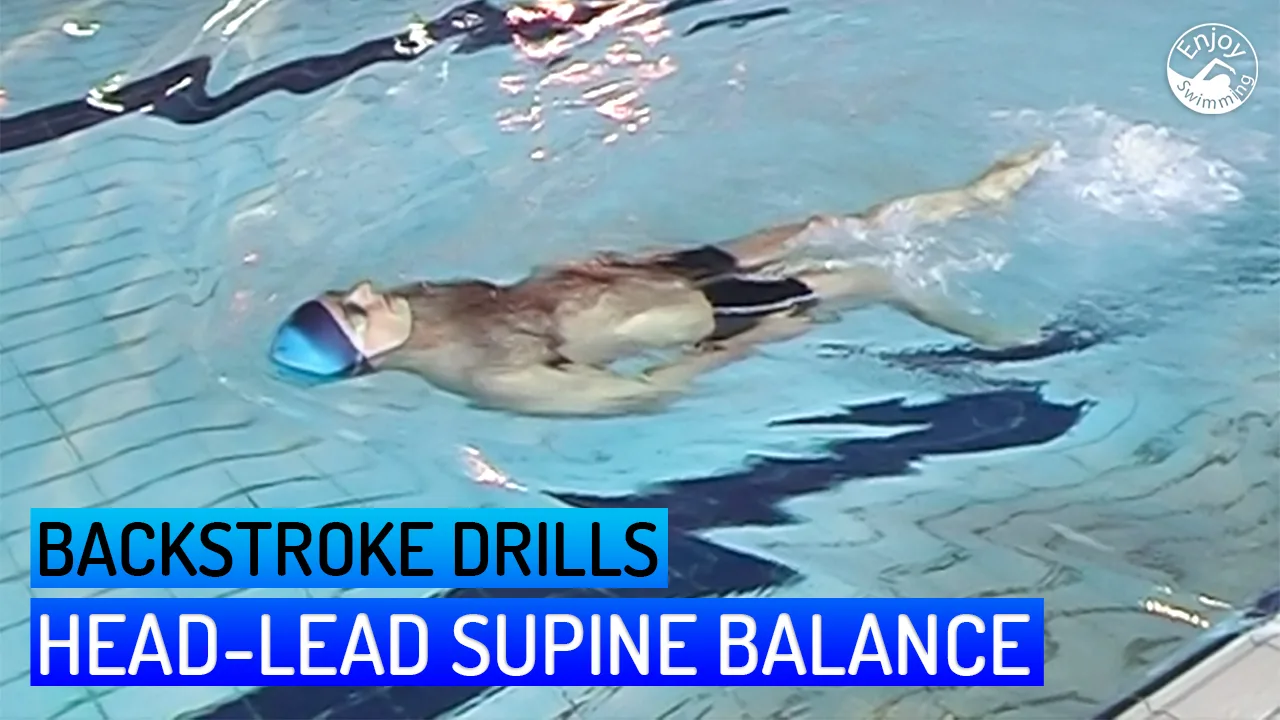Head-lead supine balance is an important drill to learn to swim backstroke, as it teaches how to be balanced and supported on your back using the buoyancy of your lungs.
Being balanced while swimming backstroke means that you can easily keep your body in a horizontal position in the water.

Swimming Drill Instructions
Here are the instructions to practice this drill. You can find an illustrative video a bit further below.
The drill will be easier to learn if you already have practiced some of the exercises to learn the flutter kick in backstroke. Do the following:
- Put on a pair of swimming goggles.
- Put on a nose clip if you are afraid of getting water into the nose.
- Go to the shallow area of the pool.
- Push off the ground and get into a horizontal position on the back.
- Start to flutter kick to provide for propulsion and to get into a horizontal position.
- Leave the arms along the sides of the body.
- Now try to move forward only using a flutter kick for propulsion and without using the arms for balance.
As a beginner, it will most likely be difficult for you to keep your balance. Therefore, keep the following points in mind:
1) You need to ensure that your body is in a straight line from head to toes. A friend or your swim teacher can be of great help to spot mistakes in your posture, for example, if you are bending the body at the hips.
2) If your legs and hips tend to sink, don’t kick harder. Try instead to push the back of the head and the upper back down in the water. Because your lungs are buoyant, this will create leverage and push the hips and legs up to the surface.
This last point is the most important insight you can get from this backstroke exercise.
Once you have learned how to push your upper body down in the water to keep the legs and hips up, it will become second nature.
As a consequence, you won’t need to kick so hard anymore, which will allow you to breathe more easily.
Video Demonstration
The video below demonstrates the swimming drill covered in this article:
Additional Tips
Use swim fins if your flutter kick doesn’t provide enough propulsion.
To be more relaxed you can use swimming goggles and a nose clip. This avoids that water enters the eyes or the nose.
When learning to balance on your back, the best strategy can be to hold your breath and practice the drill for a few seconds, then stop to take a breath, and start again.
Finally, once you have learned how to keep balance on your back, you can remove the nose clip and breathe freely.
Conclusion
Once you can keep balance on the back using only a flutter kick for propulsion, you are a big step forward on your journey to learn to swim the backstroke. So take your time to master this drill and have fun while practicing!
Learning Path for the Backstroke
Below is an overview of our series of articles on learning the backstroke. Each article in this series contains one or more drills that have to be mastered. The current article is highlighted:
Once you have gone through all the steps of this learning path, you should be able to swim backstroke without any problems.
Good luck!

Vikas
Sunday 2nd of December 2018
Hi Christophe
Came across your blog. Was interested in it because it's written for a non-commercial purpose, unlike many other blogs.
I'm 44 and have been learning to swim on and off. This time it's been 6 weeks. I'm determined to learn swimming because this is a low impact exercise compared to running.
I've been running for 4 years but its impact on knees is well known. So, want to switch to swimming.
One of the troubles is sinking legs. I think what you refer to here 'push the upper body down in the water' makes sense.
What's your view about using the core? Asking as on some other blogs I read the sinking problem is because we don't activate our use or use or core but your blog doesn't refer to it.
Christophe
Sunday 2nd of December 2018
Hi Vikas,
I've come across the 'using the core' concept as well while reading other blogs.
In my understanding, what is meant is that you consciously contract the abdominal and lower back muscles to keep your hip and torso aligned.
It makes sense, and I've played at times with this technique in the pool.
However, while it may keep your body straight and reduce the drag you create in the water, I don't think it's sufficient to avoid the dreaded sinking legs problem.
I think the additional step of leaning into the water with your back and head, so that your body acts like a seesaw and your legs move up, is also needed and in fact more important.
Once you have learned this latter technique, it becomes natural and automatic, and you won't have to think about it to keep your body horizontal and your legs up.
Good luck!